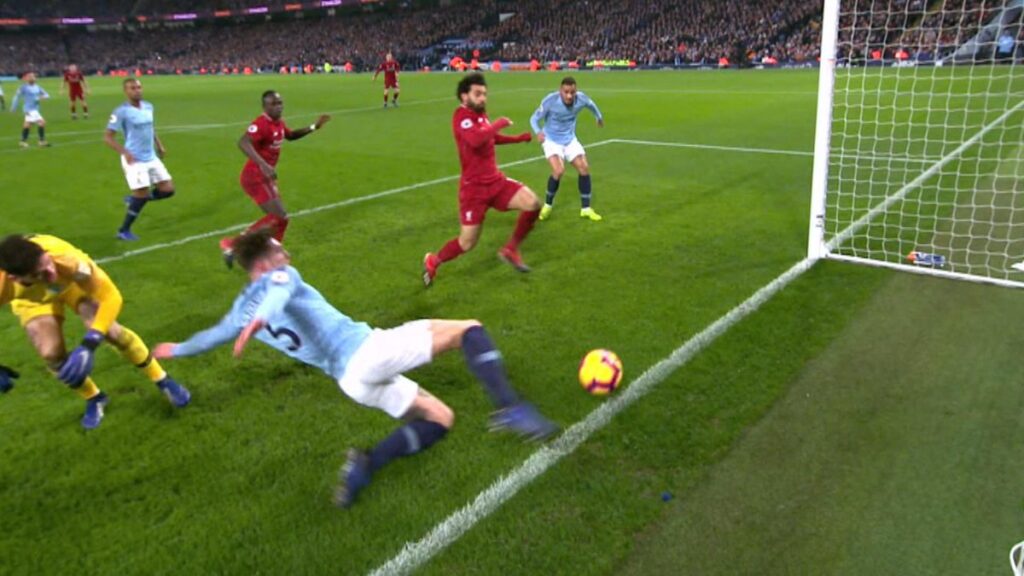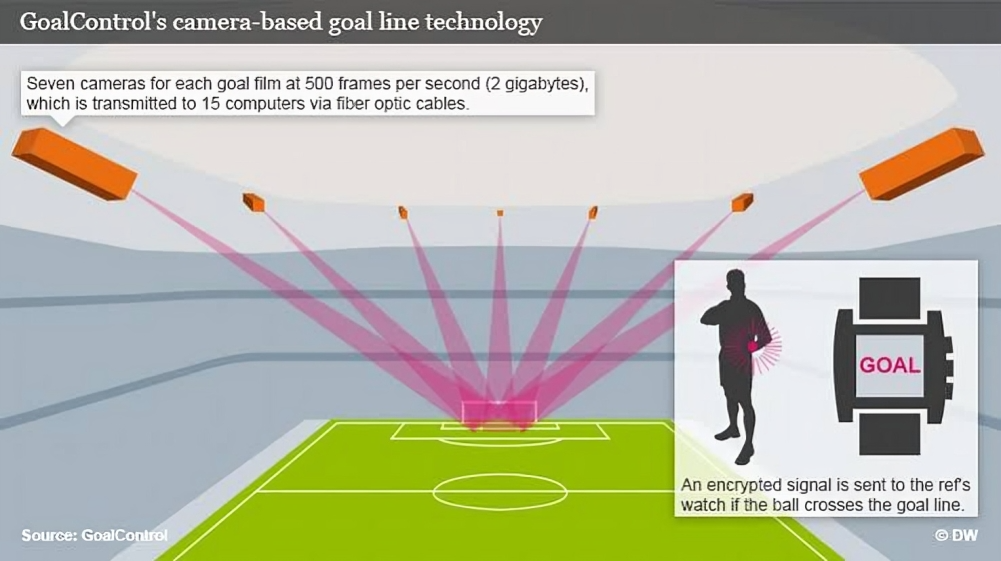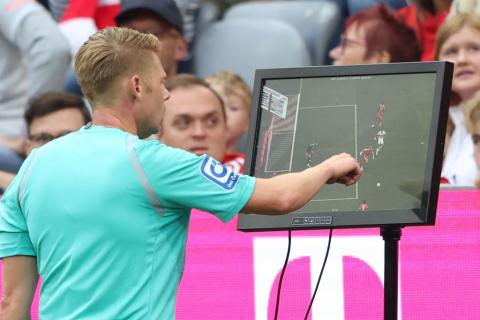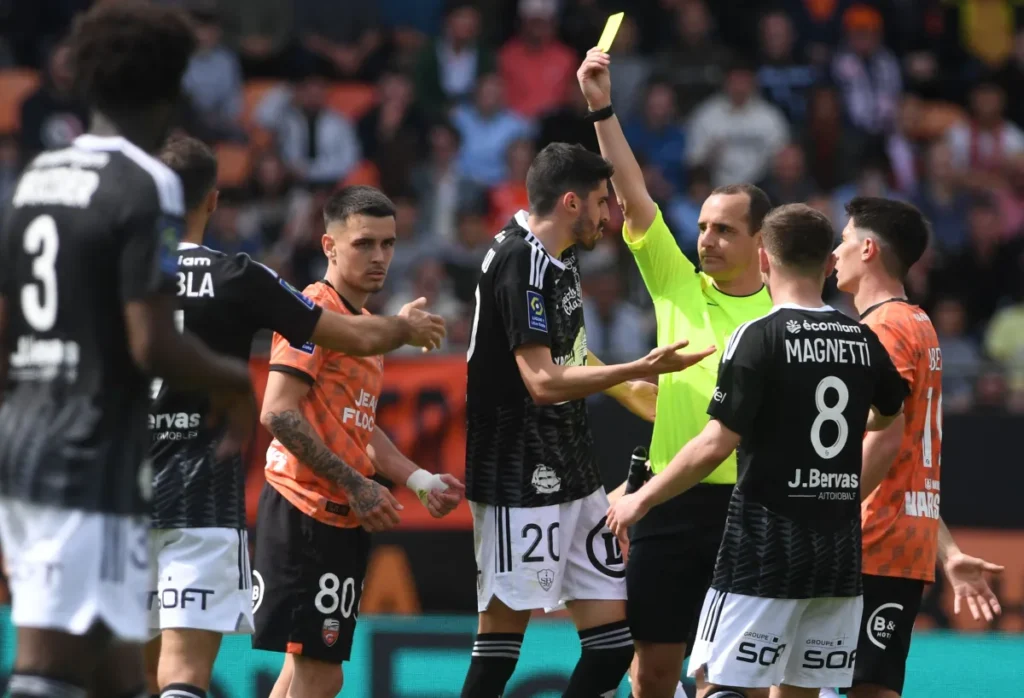Ever wondered if your favourite team was robbed of a goal? Goal line technology has revolutionised the world of football by providing clear answers to these high-stakes questions. This article dives into the origins and workings of this game-changing tech, ensuring you’ll never be left in doubt during match-critical moments.
Keep reading – it’s a game changer!
Understanding Goal Line Technology

Goal line technology in football serves as an unbiased eye that monitors the goalposts and crossbar to definitively decide if a ball has crossed the goal line. This system has become an essential component of modern refereeing, ensuring fair play and accuracy during fast-paced games.
High-speed cameras or advanced magnetic field systems linked with computers can instantly relay information to a watch worn by the referee, leaving no room for doubt about whether a goal should be awarded.
This innovation came into prominence after high-profile incidents where goals were incorrectly called, affecting game outcomes. Now, International Football Association Board sanctions its use under strict regulations to maintain the integrity of matches at all levels; from local leagues to grand tournaments like the FIFA World Cup.
Tech partners work closely with football associations to install and maintain these sophisticated networks that have reshaped how decisions are made on the pitch.
Also Read: VAR: Friend or Foe? Understanding the Technology’s Impact
The Evolution of Goal Line Technology

The evolution of goal line technology has seen significant advancements in the way it is implemented and utilised in football matches. From its pre-implementation history to its introduction and development, the journey of goal line technology has revolutionised the game and added a new dimension to decision-making on the field.
Pre-implementation History
Long before goal-line technology became a reality in football, the sport had its fair share of controversies over whether or not the ball crossed the line. These moments often led to heated debates among players, referees, and fans alike.
One famous incident was during the 2010 FIFA World Cup when Frank Lampard’s shot hit the crossbar and landed well past the goal line against Germany, but the goal was not awarded. Such pivotal instances spurred demand for a technological solution that could accurately verify goals.
Referees relied heavily on their own eyesight and perspective to make split-second decisions about potential goals – high-stress situations where human error could easily creep in.
The Premier League’s advocacy for electronic aids grew as errors continued to impact significant matches. Football authorities started considering how technology could assist officials in making accurate calls without interrupting the flow of play—setting off developments that would eventually lead to fully integrating goal-line technologies into modern football games.
Introduction and Development
Goal Line Technology burst onto the football scene to solve a critical problem: the difficulty in determining whether the ball had completely crossed the goal line. This innovation promised to deliver quick and accurate decisions, enhancing the flow and fairness of the game.
- The call for technological assistance in football grew louder after several high – profile incidents where goals were wrongly allowed or disallowed. Fans, players, and officials alike felt the frustration.
- FIFA took these concerns seriously, especially following a controversial incident at the 2010 World Cup where England’s Frank Lampard had a clear goal denied. This moment intensified calls for change.
- The Premier League emerged as a strong advocate for Goal Line Technology. Their support came from a commitment to maintaining the integrity of matches.
- The journey began with extensive discussions among FIFA, technology developers like Hawk – Eye Innovations, and footballing bodies to ensure that any introduced system would meet strict standards.
- In 2012, Goal Line Technology got its official nod from the International Football Association Board (IFAB), which maintains the laws of association football.
- Testing phases included rigorous trials of different systems across multiple venues to select the most effective solution for detecting goals with precision.
- Hawk-Eye was picked by FIFA for its Camera-Based System, relying on multiple cameras trained on each goal-post to track ball movement accurately.
- The Magnetic Field System known as GoalRef also received approval but was based on using magnetic sensors to detect ball position within the goal area.
- Adoption was swift; by 2013/14 season, all English Premier League stadiums were equipped with Goal Line Technology systems to assist referees in real-time during matches.
- The debut of this technology saw immediate benefits as it definitively resolved disputes over ‘phantom’ goals, ensuring transparent outcomes in games.
Also Read: Why Is Dribbling Important in Football: The Key to Success on the Field
How Does Goal Line Technology Work?
Goal Line Technology works through the use of camera-based or magnetic field systems to determine whether a goal has been scored. These advanced technologies provide accurate and efficient decision-making during football matches.
Camera-Based Systems
Camera-based systems in goal-line technology represent a game-changer for football. Rigged around the pitch with fourteen high-speed cameras, these innovative tools ensure that no goal-scoring moment goes unnoticed.
Seven cameras focus meticulously on each goal, rapidly capturing images and feeding data to a computer system. The tech scrutinises the ball’s position in relation to the goal line, making split-second decisions.
GoalControl is one such advanced system leading the charge in modern football officiating. With its network of 14 cameras strategically placed to overlook every angle of the goals, it delivers precise and accurate decisions that help maintain the integrity of the sport.
This method leaves little room for error, providing teams and fans alike with instant clarity during those nail-biting moments that could determine victory or defeat on the pitch.
Magnetic Field Systems
Magnetic field systems in goal-line technology represent a game-changing blend of sports and cutting-edge tech. The GoalRef™ system, for instance, relies on an electromagnetic approach to accurately determine if the ball has crossed the line.
Picture this: underneath the pitch and within the goalposts lies a network of cables or devices that create a magnetic field around the goal area.
Imagine every move being tracked – as soon as the specially equipped football enters this invisible grid, its internal chip senses those fields. Swiftly, it sends data to referees who can then instantly confirm whether a game-deciding goal has been made.
This ensures fairness in every match without disrupting the flow of play—a triumph for fans yearning for both excitement and precision on the field.
Also Read: Why Are Number 7 and 10 So Special in Football?
Criticisms of Goal Line Technology
Some critics argue that goal line technology takes away the human element and spontaneity from the game, while others raise concerns about the cost implications and potential system failures.
However, despite these criticisms, goal line technology has made significant strides in enhancing the accuracy of decision-making in football matches.
Loss of Human Element
Goal-line technology has reshaped football by giving precise answers to contentious goal disputes. Yet, this shift carries with it the fading presence of human judgment on the pitch.
Critics argue that such technologies strip away layers of passion and storytelling from the game. They believe there’s a unique value in referees making calls based on their expertise and perspective, something that no algorithm or camera system can replicate.
The removal of these spontaneous debates among fans pulls at the very fabric of what makes football more than a sport: its ability to unite us in shared joy or dispute. We’re left with fewer moments where we collectively hold our breaths, awaiting an umpire’s decision — those seconds where every fan becomes an expert and every living room turns into a tribunal.
This is not just about whether a ball crossed the line; it’s about what happens when machines override human experiences on the field of play.
Cost Implications
Implementing goal line technology comes with a hefty price tag. Premier League teams have had to shell out approximately £250,000 each for the system to be installed in their stadiums.
This significant investment reflects the high cost of state-of-the-art equipment and the expertise required to run it seamlessly during matches.
Clubs weigh these expenses against the benefits of accurate goal decisions. While some argue that this cost is essential for preserving the integrity of the game, others question if such an amount could be better spent on developing grassroots football or other improvements within clubs.
Regardless, this tech has set a new financial standard in top-tier leagues that smaller clubs may find challenging to meet.
System Failures
Following the cost implications, it’s essential to consider potential system failures associated with goal line technology. These failures can impact the accuracy and reliability of the technology, leading to contentious decisions in football matches. Here are some key points to consider:
- Calibration issues: Inaccurate calibration of the goal line technology components can lead to incorrect judgments on whether a goal has been scored or not.
- Technical glitches: Like any technological system, goal line technology is susceptible to technical malfunctions, such as camera errors or sensor failures, which can compromise the accuracy of its decisions.
- External interference: Environmental factors like extreme weather conditions or physical obstructions on the field may interfere with the proper functioning of goal line technology systems.
- Maintenance challenges: Regular maintenance and upkeep are crucial for ensuring optimal performance of goal line technology systems; failure to do so can result in inaccuracies during crucial match moments.
- Referee reliance: There may be instances where referees become overly dependent on the technology, leading to potential oversight of other crucial aspects of decision-making during a game.
- Data interpretation errors: Interpreting data from multiple cameras or sensor arrays requires precision and careful analysis; errors in this process can lead to incorrect goal/no-goal decisions.
- System compatibility issues: Integration challenges between different technologies within a stadium or inconsistencies between different stadiums’ setups can lead to performance discrepancies across matches.
The Future of Goal Line Technology
Goal-line technology continues to advance, with ongoing research and development aiming to enhance its accuracy and efficiency. This will involve further refinements to existing systems and possibly the introduction of new technologies.
The future of goal-line technology is set to bring even more precision and reliability, ensuring that crucial decisions in football matches are made correctly without any margin for error.
Innovations in goal-line technology seek to keep pace with the demands of modern football, guaranteeing fairness and integrity in the game. As advancements continue, fans can look forward to even greater confidence in match officiating as well as an exciting evolution of how technology influences the beautiful game.
Also Read: The Importance of Communication in Football
Conclusion
In conclusion, goal line technology has significantly evolved, revolutionising the way goals are determined in football. The introduction of camera-based and magnetic field systems has enhanced the accuracy and precision of goal-line decisions.
Despite criticisms regarding the loss of human element and cost implications, the system continues to prove its value. Looking ahead, ongoing interest and development demonstrate a commitment to further improving goal line technology for future use in football matches worldwide.
FAQs
1. What is goal line technology in football?
Goal line technology is a high-tech method used to determine whether the entire ball has crossed the goal line, helping referees make accurate decisions during matches.
2. When and why was goal line technology introduced into football?
Goal line technology was introduced after the FIFA 2010 World Cup, driven by incidents like Thierry Henry’s infamous handball, it aimed at preventing ‘ghost goals’ and ensuring fair play.
3. At which tournament did we first see goal line technology in action?
The prestigious FIFA World Cup trophy saw goal-line technology used for the first time during the 2014 tournament to assist referees with crucial decision-making.
4. Are there advantages to using this type of technology in games?
Indeed, advantages include quick and correct decisions on ‘phantom goals’, reducing errors that affect game outcomes and supporting referees with instant replays leading few stoppages.
5. Is there complete accuracy with goal-line tech or can it fail sometimes?
While highly reliable, no system boasts perfection; Goal-Line Technology may occasionally face limitations due to technical malfunctions or unusual game situations.
6. Has this tech been adopted outside of football as well?
Absolutely! Sports such as international cricket have embraced similar systems like Hawk-Eye for precise lbw (leg-before-wicket) decisions illustrating its wider impact beyond football’s stumps and posts.


